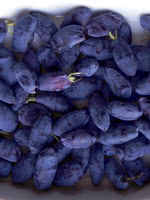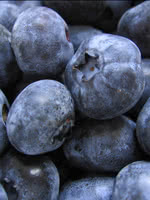Mon-Fri 9am - 5pm Mountain time
Honey Bee Haskap (Honeyberry) vs Top Hat Blueberry
Lonicera caerulea Honey Bee
Vaccinium x Top Hat
NOT AVAILABLE THIS SEASON - MIGHT RETURN
NOT AVAILABLE THIS SEASON - MIGHT RETURN
Honey Bee Haskap produces tarter fruit than the Aurora and Borealis varieties and is known for bearing fruit at a younger age. The flavour of Haskaps is generally described as a cross between a blueberry and a raspberry. Honey Bee Haskaps are well suited to fresh eating, freezing, baking, and preserves.
The Honey Bee Haskap has stronger fruit holds than other varieties so the berries stay on the bush longer. The berries do not roll well so they are not recommended for mechanical harvesting.
For optimal fruit production, cross-pollination is required. Haskaps need to be planted with a compatible variety. Compatibility is influenced by both bloom time and genetics.
Honey Bee Haskap is an early-pollinating variety and pairs well with Aurora, Borealis, Tundra, and Indigo Gem.
Top Hat Blueberry is ideal for decks, patios, and small yards. This compact blueberry produces loads of good tasting berries early in the summer. This variety's berries are well suited for baking.
While Top Hat Blueberry is self-pollinating, we recommend pairing it with another suitable blueberry to increase the berry production of both varieties.
We recommend planting Top Hat Blueberry into the ground or into planters that have at least 5 gallons of soil per plant for the best results. Do not plant them into pots (voids your guarantee).
Note: Blueberries require very specific soil conditions. They need well-drained soil with a pH between 4.5 and 5.0. If the starting pH of your soil is between 5.1 and 6.2 you can lower it by adding sulfur. We recommend against planting blueberries in soil with a starting pH greater than 6.2. Please do your own research before buying any blueberry plants.

